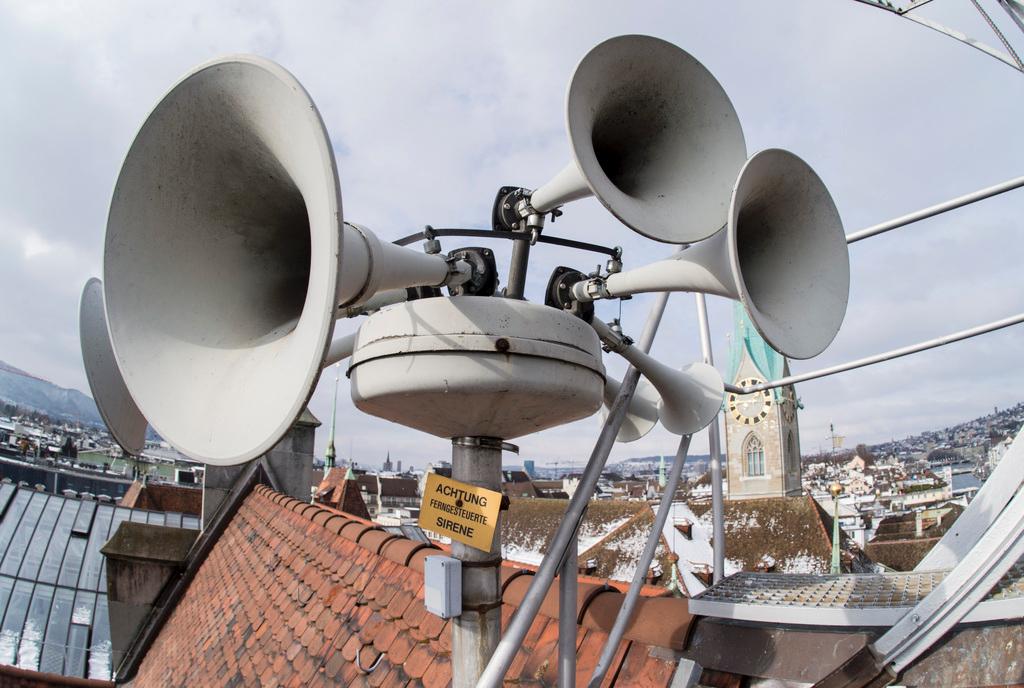Sirens get a boost from social media

Switzerland has added social media to its more traditional attention-grabbing sirens to help spread the word in case disaster strikes.
The government’s Alertswiss channel, combined with a blog, tweets and a smartphone app, might be joined by phone alerts via SMS and cell broadcasts starting in 2017 to bolster the system of fixed and portable sirens put to the annual test on Wednesday.
“There is certainly an international trend to integrate mobile technologies in public alerting systems,” says Florian Roth, a researcher with the Center for Security Studies at the Swiss Federal Institute of Technology Zurich. He attributes the trend to a shift away from “one-way” crisis communication.
With more “multidirectional” crisis communication, he tells swissinfo.ch, “the citizens are not only the passive receivers of official information, but can also contribute valuable information themselves. In this context, mobile technologies offer great opportunities to improve information exchange between authorities and the public.”
7,800 sirens
Residents know to cover their ears every year on the first Wednesday in February, when authorities test 7,800 sirens across Switzerland. Some 5,000 are mounted on rooftops or poles; the other 2,800 are portable and spread around the country to reach remote areas, according to Alertswiss, a joint project of the federal government and Swiss cantons.
Most of the sirens are general alarms, which go up and down in tone. The other type is a water alarm, which has a low tone. These are for people living below dams. The two systems are tested for up to an hour and a half. A new feature this year is the ability to operate some of them by remote control. But the Federal Office for Civil Protection, which oversees the testing, also is working with cantons and organisations to boost preparedness using alertswiss.chExternal link, @Alertswiss and other new technologies, including social media and smartphone apps.
“We have to inform the public in the future by all modern means,” says the director of the office, Benno Bühlmann. “Not everyone today has a radio.”
The launch of the Alertswiss channel is the first step of a comprehensive information programme to alert the public during disaster and emergency situations, according to Kurt Münger, the office’s communications chief. In the future, he says, these channels will also be used to inform the public more quickly, more efficiently and in more detail in an actual event.
Wars to tweets
The Swiss, like the British, introduced the sirens during wartime. Their purpose remained mostly military throughout the Cold War. Now they are used to warn of emergencies and disasters such as flooding. People are given advance notice about the siren tests on television broadcasts as well as in the newspapers. The tests do not require the population to take any special measures.
When the real thing happens – in Bern, for example, the general alarm went off in 2007 when the Aare River threatened to overflow its banks – people are advised to switch on a radio for instructions. But with water alarms, those living below dams are urged not to wait but to leave immediately.
The Swiss system is more pervasive than most. Some of the portable sirens can be mounted on cars. In some ways, they complement the underground bunkers to which nearly all members of the population have access.
Around Europe, countries such as Austria and France use sirens. Italy and Germany no longer have nationwide networks. The Dutch were quick to start using mobile phones with the cell broadcast system. In the United States, where the sirens are linked to natural disasters, the national weather agency has been building a text emergency alert system.
The Swiss civil protection system, which includes the sirens, has worked well over the last decades, Roth says, though he notes that critics believe it has never really been tested by a large-scale disaster. And the sirens’ ability to reach the masses is offset by the limited information they convey.
TV and radio have traditionally complemented the alarm-sounding, he says, but as media changes, the use of mobile technologies “can be very effective for filling this information gap” – especially among younger generations.
“It would certainly be unwise to abolish an established information system overnight,” Roth says. “Instead, communication channels like the sirens have to be updated to match the changing technological standards and also society’s needs. This is what we can observe currently in Switzerland.”

In compliance with the JTI standards
More: SWI swissinfo.ch certified by the Journalism Trust Initiative











You can find an overview of ongoing debates with our journalists here . Please join us!
If you want to start a conversation about a topic raised in this article or want to report factual errors, email us at english@swissinfo.ch.